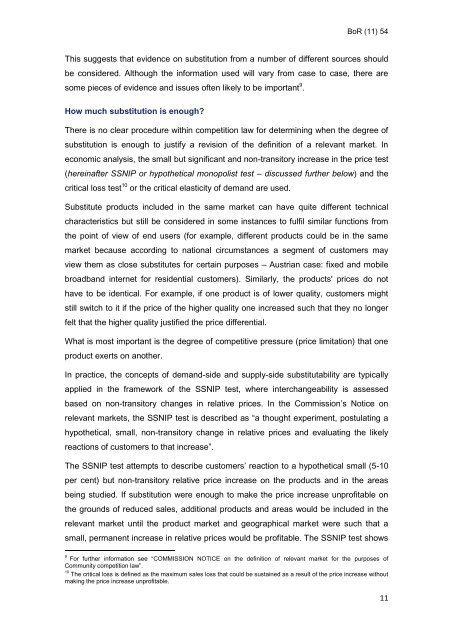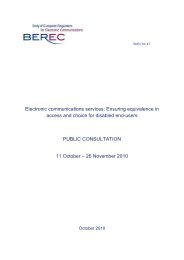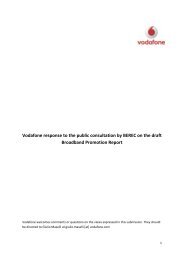BEREC REPORT ON IMPACT OF FIXED-MOBILE ... - berec - Europa
BEREC REPORT ON IMPACT OF FIXED-MOBILE ... - berec - Europa
BEREC REPORT ON IMPACT OF FIXED-MOBILE ... - berec - Europa
You also want an ePaper? Increase the reach of your titles
YUMPU automatically turns print PDFs into web optimized ePapers that Google loves.
BoR (11) 54<br />
This suggests that evidence on substitution from a number of different sources should<br />
be considered. Although the information used will vary from case to case, there are<br />
some pieces of evidence and issues often likely to be important 9 .<br />
How much substitution is enough?<br />
There is no clear procedure within competition law for determining when the degree of<br />
substitution is enough to justify a revision of the definition of a relevant market. In<br />
economic analysis, the small but significant and non-transitory increase in the price test<br />
(hereinafter SSNIP or hypothetical monopolist test – discussed further below) and the<br />
critical loss test 10 or the critical elasticity of demand are used.<br />
Substitute products included in the same market can have quite different technical<br />
characteristics but still be considered in some instances to fulfil similar functions from<br />
the point of view of end users (for example, different products could be in the same<br />
market because according to national circumstances a segment of customers may<br />
view them as close substitutes for certain purposes – Austrian case: fixed and mobile<br />
broadband internet for residential customers). Similarly, the products' prices do not<br />
have to be identical. For example, if one product is of lower quality, customers might<br />
still switch to it if the price of the higher quality one increased such that they no longer<br />
felt that the higher quality justified the price differential.<br />
What is most important is the degree of competitive pressure (price limitation) that one<br />
product exerts on another.<br />
In practice, the concepts of demand-side and supply-side substitutability are typically<br />
applied in the framework of the SSNIP test, where interchangeability is assessed<br />
based on non-transitory changes in relative prices. In the Commission’s Notice on<br />
relevant markets, the SSNIP test is described as “a thought experiment, postulating a<br />
hypothetical, small, non-transitory change in relative prices and evaluating the likely<br />
reactions of customers to that increase”.<br />
The SSNIP test attempts to describe customers’ reaction to a hypothetical small (5-10<br />
per cent) but non-transitory relative price increase on the products and in the areas<br />
being studied. If substitution were enough to make the price increase unprofitable on<br />
the grounds of reduced sales, additional products and areas would be included in the<br />
relevant market until the product market and geographical market were such that a<br />
small, permanent increase in relative prices would be profitable. The SSNIP test shows<br />
9<br />
For further information see “COMMISSI<strong>ON</strong> NOTICE on the definition of relevant market for the purposes of<br />
Community competition law”.<br />
10<br />
The critical loss is defined as the maximum sales loss that could be sustained as a result of the price increase without<br />
making the price increase unprofitable.<br />
11





